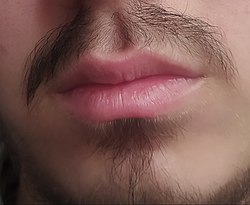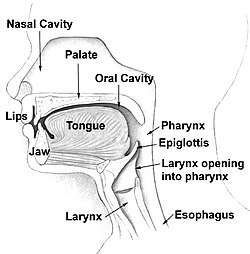
Back جوف الفم Arabic মুখ Assamese Ağız boşluğu Azerbaijani Ngimot nin tawo BCL মানব মুখ Bengali/Bangla دەمی مرۆڤ CKB Этем çăварĕ CV Ceg ddynol Welsh އަނގަ DV Ανθρώπινο στόμα Greek
| Human mouth | |
|---|---|
 Photograph of the closed mouth of a male | |
 Head and neck | |
| Details | |
| Identifiers | |
| Latin | os, oris[1] |
| TA98 | A01.1.00.010 |
| TA2 | 119 |
| Anatomical terminology | |
In human anatomy, the mouth is the first portion of the alimentary canal that receives food and produces saliva.[2] The oral mucosa is the mucous membrane epithelium lining the inside of the mouth.
In addition to its primary role as the beginning of the digestive system, the mouth also plays a significant role in communication. While primary aspects of the voice are produced in the throat, the tongue, lips, and jaw are also needed to produce the range of sounds included in speech.
The mouth consists of two regions, the vestibule and the oral cavity proper. The mouth, normally moist, is lined with a mucous membrane, and contains the teeth. The lips mark the transition from mucous membrane to skin, which covers most of the body.
- ^ Schröder, Hannsjörg; Moser, Natasha; Huggenberger, Stefan (2020). Neuroanatomy of the Mouse: An Introduction. Springer International Publishing. p. 105. ISBN 978-3-03019-898-5. Retrieved December 24, 2023.
- ^ Maton, Anthea; Jean Hopkins; Charles William McLaughlin; Susan Johnson; Maryanna Quon Warner; David LaHart; Jill D. Wright (1993). Human Biology and Health. Englewood Cliffs, New Jersey, USA: Prentice Hall. ISBN 0-13-981176-1.